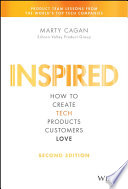

One of the core tenets of 'Inspired' is the emphasis on understanding customer needs. The author, Marty Cagan, argues that successful product teams must prioritize empathy and deep understanding of their users. This involves conducting user research, interviews, and surveys to gather insights into what customers truly want and need. By focusing on the problems that users face, product teams can develop solutions that resonate with their audience. Cagan emphasizes that it is not enough to rely on assumptions or surface-level feedback; teams must engage directly with customers to uncover their pain points and desires. This deep understanding helps in creating products that are not only functional but also delightful to use. Furthermore, Cagan highlights the importance of continuous feedback loops, where teams iteratively test and refine their products based on real user interactions. This customer-centric approach is crucial for ensuring that the final product aligns well with market demands and user expectations.
Continue readingCagan delineates the critical role of product managers within product teams. He posits that a product manager is not merely a project manager or a liaison between departments, but rather a visionary who understands both the market and the technical aspects of product development. The product manager is responsible for defining the product vision and strategy, prioritizing features, and making tough trade-off decisions. Cagan stresses the importance of having a strong product manager who can advocate for the user while balancing business objectives. This role requires a unique blend of skills, including communication, analytical thinking, and leadership. A successful product manager is also adept at fostering collaboration among cross-functional teams, ensuring that everyone is aligned and working towards a common goal. Cagan provides insights into how product managers can effectively communicate their vision and rally their teams, ultimately driving the product development process forward.
Continue readingIn 'Inspired', Cagan emphasizes the significance of building cross-functional teams that include members from various disciplines such as engineering, design, marketing, and sales. He argues that diverse perspectives are essential for creating innovative products. By bringing together individuals with different skill sets and backgrounds, teams can brainstorm solutions that are more comprehensive and creative. Cagan also discusses the importance of fostering a culture of collaboration and trust within these teams. When team members feel empowered to share their ideas and challenge each other constructively, the result is a more dynamic and effective product development process. Additionally, he highlights the need for clear roles and responsibilities within the team to ensure accountability while still encouraging open communication. This approach not only enhances the quality of the product but also increases team morale and engagement.
Continue readingCagan advocates for the use of prototyping and validation as crucial steps in the product development process. He encourages teams to create low-fidelity prototypes to quickly test ideas and gather user feedback before investing significant resources into full-scale development. This iterative process allows teams to validate assumptions, identify potential issues, and refine their concepts based on real-world interactions. Cagan emphasizes that prototyping is not just about creating a tangible product; it is also about fostering a mindset of experimentation and learning. By embracing failure as a valuable part of the process, teams can iterate more effectively and arrive at a solution that truly meets user needs. Furthermore, he discusses various prototyping techniques and tools that teams can leverage to streamline this process and enhance collaboration.
Continue readingCagan highlights the significance of cultivating a strong product culture within organizations. He argues that a healthy product culture fosters innovation, encourages risk-taking, and supports continuous learning. This culture is characterized by a shared understanding of the product vision, open communication, and a commitment to user-centric design. Cagan stresses that leadership plays a crucial role in shaping this culture. Leaders must model the behaviors they wish to see in their teams, such as openness to feedback and a willingness to experiment. Additionally, he discusses the importance of recognizing and rewarding team members for their contributions to the product development process. By creating an environment where employees feel valued and empowered, organizations can boost morale and drive better product outcomes.
Continue readingIn 'Inspired', Cagan addresses the importance of metrics and success measurement in product development. He argues that teams must define clear, actionable metrics that align with their product goals and user needs. These metrics should not only measure output (such as the number of features delivered) but also outcomes (such as user satisfaction and engagement). Cagan emphasizes that the right metrics can provide valuable insights into how well a product is performing and where improvements are needed. He also discusses the concept of 'north star metrics'—key indicators that guide teams in their decision-making and keep them focused on delivering value to users. By regularly reviewing and analyzing these metrics, teams can make informed decisions and pivot their strategies as necessary to ensure long-term success.
Continue readingCagan concludes 'Inspired' with a discussion on the necessity of adaptability and continuous learning in the product development landscape. He emphasizes that the market is constantly evolving, and product teams must be prepared to adjust their strategies and approaches in response to new information and changing user needs. This requires a mindset that embraces change and views challenges as opportunities for growth. Cagan encourages teams to foster a culture of learning, where experimentation and feedback are integral to the process. By staying curious and open to new ideas, product teams can remain relevant and competitive in a fast-paced environment. He also highlights the importance of post-launch analysis, where teams reflect on their successes and failures to inform future projects.
Continue reading